TEAM EARTH – How do we facilitate massive planetary cooperation?
The proposed platform will facilitate massive planetary cooperation by expanding the corporation’s identity to include the communities within which they operate. How can we organize this into existence?
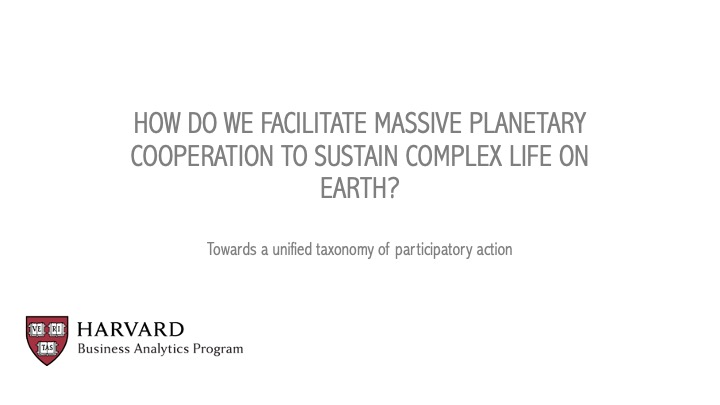
At this moment in spacetime, we humans find ourselves in an existential crisis. Our existing global operating system is fundamentally out of balance with the natural cycles of planet Earth. In order to sustain complex life on this planet, by some estimates, we must make significant techno-structural changes to our existing global economic systems within the next 8-10 years. However unrealistic that may sound to you reading this, please try to keep an open mind.
If we do not act swiftly at a global scale, we can anticipate a rise in new and novel zoonotic diseases, sea level increases up to 4 feet, continued species extinction at unprecedented scale, and potentially our own catastrophic demise as a global civilization. There are limits to growth, and we have already exceeded them. The current global economy consumes approximately 1.5-1.7x the amount of resources that the Earth is capable of replenishing in a given year. This is not sustainable.
Unless we begin to challenge our assumptions, beliefs, and biases about the role of the corporation in this global ecosystem, we will likely witness an increase in wars, famines, social unrest, and violence resulting from lack of fresh water, food scarcity, and resource scarcity.
There is another way through this storm. It involves finding new leverage points within our existing systems that crack open the hearts and minds of leaders across the planet. Shifting consciousness away from us vs. them dichotomous understandings of the Self, towards a unified vision for all life on Earth. Nobody says this is going to be easy. In fact, in all likelihood, we will fail.
As Prof. Tushman says, “the same things that made us successful in the past will lead to our failure in the future.” So now is the time to innovate, to explore, and to radically re-envision what things we actually can change in our lifetime.
Buckle up, this could get bumpy.
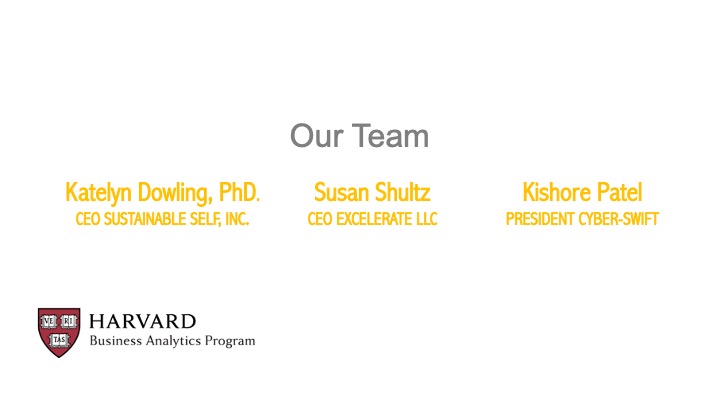
In order to immerse yourself in this presentation, we encourage you to put yourself in the shoes of a child. Allow yourself to access your innate capacity for imagination in service of our common goal. Allow yourself to witness the thoughts that come to your mind without judgment and maintain an open-heart throughout the presentation.
In fact, we encourage you to visualize your breath going into your heart, and to actually cultivate the emotion of love. Doing this will allow your brain and your body to enter into what is called a state of coherence. Where your brain waves shift into alpha – or “sine-like” state. This is important.
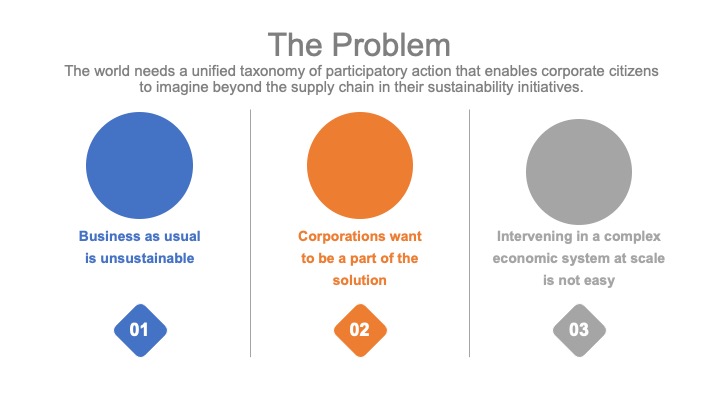
There is a paradigm shift happening globally, you can sense this in your entire body. Leaders across the globe are having backdoor conversations with one another about how to broaden stakeholder value beyond traditional metrics. But the departments within their organizations that focus on community impact (like corporate social responsibility, or corporate giving offices) are not integrated into the core business model of the company.
The “hot topic” on everybody’s mind is this idea of Environment and Social Governance (ESG), but despite attempts by some governments to mandate disclosure of internal statistics, many companies are left wondering what it all really means and how it applies to their bottom line. At the end of a hectic day just trying to keep the business afloat, senior executives and CEOs are having dinner-table conversations with their teenage children who beg them to step up and do something with their power to address racial inequality, environmental degradation, and climate change.
But it is incredibly difficult to intervene in a complex system as dynamic and large as the global economy. Nobody really knows how to do it. If we had done it already, we wouldn’t be here… Yet with each passing year, we fail to make the changes needed to reverse course. The fires are more severe, the storms are more frequent, the biodiversity of life on this planet is disappearing faster than you can even imagine.
That’s where Participatory Action Research (PAR) comes in. PAR is an approach that seeks to understand the world by trying to change it. This is done collaboratively through data collection and deep reflection. PAR emphasizes collective inquiry and experimentation grounded in experience and social history.
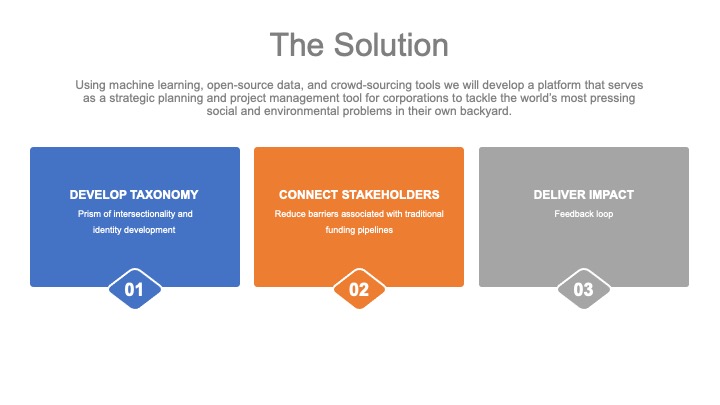
With this proposal, we are seeking funding for the initial development of a platform built around a proprietary taxonomy. If adopted at scale this type of platform could drive positive feedback loops between industry (e.g. large corporations) and financial markets (e.g. investors). Think of it like a trojan horse – intended to facilitate massive investment in projects and programs that vector towards United Nations Sustainable Development Goals (UNSDG) and other global goals.
We intend to build a taxonomy around a participatory action model of intersectional sustainability.
The concept for this platform is deeply rooted in the work of famous systems theorists like Donella Meadows and the irreverent tone in this narrative is brought to you by motivational interviewing and acceptance and commitment therapy. But all that really matters is you keep breathing with your heart…. So inhale love and exhale peace.
In the slides that follow you will begin to see the foundation of the proposed taxonomy and why it is important. Bear in mind, however, that no taxonomy alone will ever tackle the problems we face as a human race. For this type of proposal to succeed, it will require massive levels of social organizing. That means YOU will need to hold the door open for us to walk through. We invite you to start imagining what doors you hold the keys to inside of your heart.
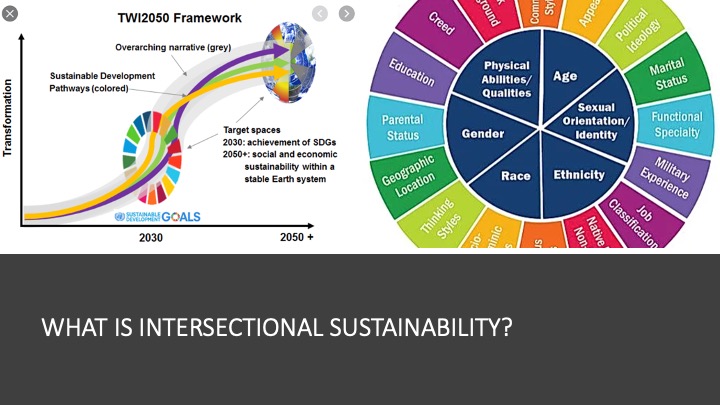
Imagine intersectionality as a prism – a mental model – or a lens through which you view the world. Intersectionality generally describes the ways in which differing layers of an individual’s identity combine. It was coined in the late 1980s by the famous Black female legal scholar Kimberle Crenshaw.
We believe it is possible to develop a taxonomy that uses publicly available data sources (e.g. census data, health disparity data, environmental hazard data, etc.) to bring intersectionality into the fold of corporate decision making.
The other driving factor that must be considered in the development of any taxonomy like the one proposed is the concept of “Planetary Boundaries.” These are the physical limitations to human activity on Planet Earth itself. While some visionaries imagine we will terraform Mars and move our species into outer space, there are still those of us down here on Earth who want to save the spaceship we’ve got. It’s pretty beautiful here and it’s perfectly suited for our species to evolve.
According to Susan Shultz, the pain point from a leadership perspective is simple: they can set the company-wide goals, but how do they drive action at the plant level?
We propose that it is possible to assign weighted values based on data in the communities where an organization operates, thereby generating a hierarchy of needs. One that is dynamic and reality-based, while also vectoring those needs to the over-arching global-goals. This would provide individuals across organizations with areas for investment that generate the greatest impact in their own backyard.
We invite you to please consider watching the video below to better understand intersectionality.
References:
https://www.ted.com/talks/kimberle_crenshaw_the_urgency_of_intersectionality?language=en
The 9 planetary boundaries include: ocean acidification, ozone depletion, nitrogen cycle, phosphorus cycle, freshwater use, deforestation and other land changes, biodiversity loss, particle pollution of the atmosphere, chemical pollution, and the climate crisis.
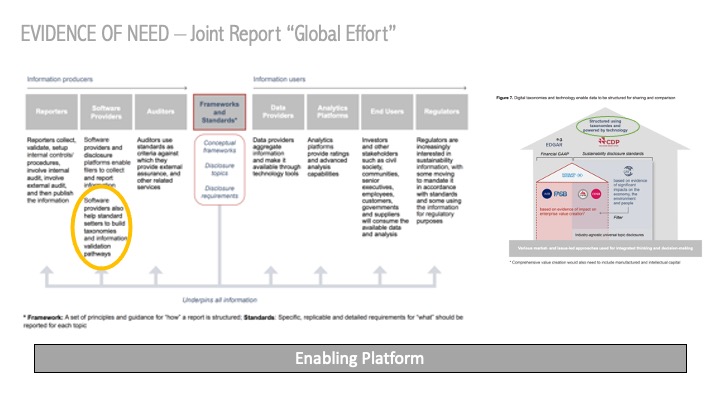
So why do we need a taxonomy? To be honest, we cannot take credit for that. This graphic is from a report that was issued in September of 2020 (links below). The timing of our proposal could not be more relevant. In fact it is a fundamental necessity at this juncture in our collective effort to sustain complex life on Earth.
- International Integrated Reporting Council
- CDP, a global not-for-profit that drives companies and governments to reduce greenhouse gas emissions, safeguard water resources, and protect forests.
- The Climate Disclosure Standards Board (CDSB),
- The Global Reporting Initiative (GRI),
- The Sustainability Accounting Standards Board (SASB).
This report calls for software providers to help standardize taxonomies and information validation pathways like those that would be developed through this proposal. The world needs this now more than ever and we are just the team to do it!
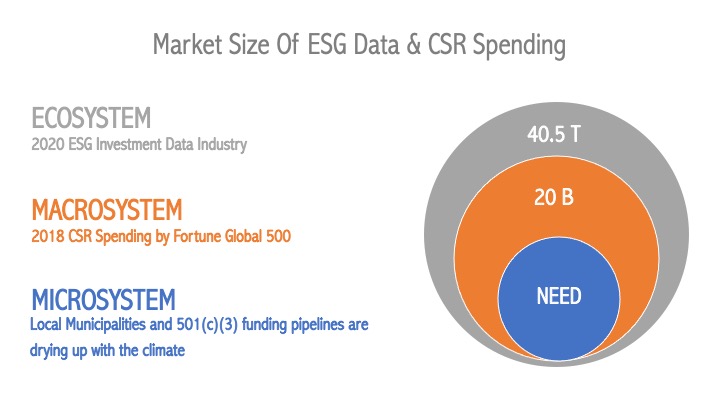 Imagine the experience of a non-profit agency providing meals and shelter to homeless people in a large urban center. Did you know that the average annual operating budget for a 501(c)(3) in the US is only $1,000,000? Now imagine how difficult it is for that organization to pay their rent and pay their employees a living wage, let alone provide the services that are desperately needed in the communities they serve.
Imagine the experience of a non-profit agency providing meals and shelter to homeless people in a large urban center. Did you know that the average annual operating budget for a 501(c)(3) in the US is only $1,000,000? Now imagine how difficult it is for that organization to pay their rent and pay their employees a living wage, let alone provide the services that are desperately needed in the communities they serve.
There is a disproportionate amount of capital floating around in the investment/financial services sector. Did you know that a 2019 study reported only 10.8% of all asset managers in a global database were female? I’m sure you also know that in 2017 only 19 Fortune 500 companies were led by people of color, and only 21 of those companies were led by women. These intersectional realities are not exclusive to big-business. In fact, among nonprofits with annual budgets of $50 million or more, only 18% had a female CEO. Sustainability is an intersectional issue.
So how do we intervene in this existing system in a way that does not make the predominantly white men in power feel threatened by the solution? Rather, how do we empower them to collaborate in service of our broader shared identity as humans on Earth? If you are a white man reading this, how does it feel to acknowledge these realities inside of your heart?
This proposed platform is designed to facilitate the movement of capital from the clouds to the Earth in a non-threatening and inclusive manner.
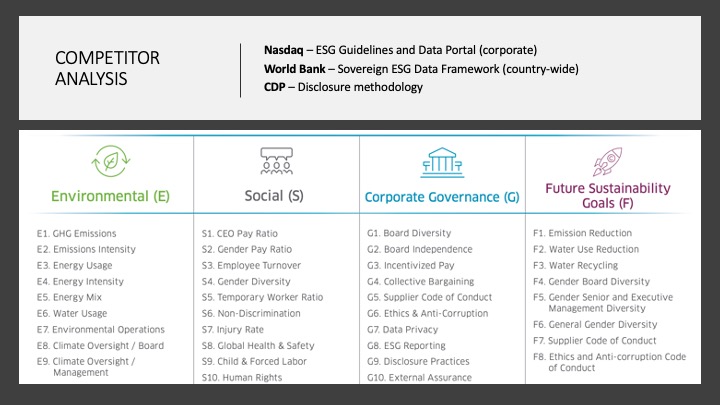
Lots of money and resources are being spent trying to crack the code on ESG. New language and standards are emerging across industries and around the globe that make the competitive landscape fierce, but also ripe for innovation.
We believe it is important to conceptualize ESG and CSR as internal and external variables (respectively) in a corporation’s identity development.
The above graphic shows some commonly used descriptors for the many internal ESG variables. Meaning those that are the direct result of a company’s existing business operations. E.g. How intensive is our energy usage in the production cycle? Do we use child labor to produce candy bars in Africa? How does policy translate into action regarding a worker’s right to organize within factories or business units?
Equally as important are the external CSR metrics associated with traditional corporate-giving departments. Businesses must stop thinking of them “selves” as separate from the global problems we all face. Leaders have a moral obligation to act quickly in service of sustaining complex life on this planet.
External variables are things like percentage of profits that go towards community-based initiatives, direct infrastructure investments in the community, grants for medical research, impact data from such initiatives supported by the organization. These variables are often secondary to existing business operations.
We need unprecedented levels of investment in BOTH internal and external variables that move us towards a more just, equitable, diverse, and inclusive future for all life on Earth.
The purpose of this platform is to aggregate internal ESG metrics while facilitating new funding pipelines for community-based initiatives. We propose to do this by providing decision-makers with a landscape of possible solutions inside and outside of their organizational structure.
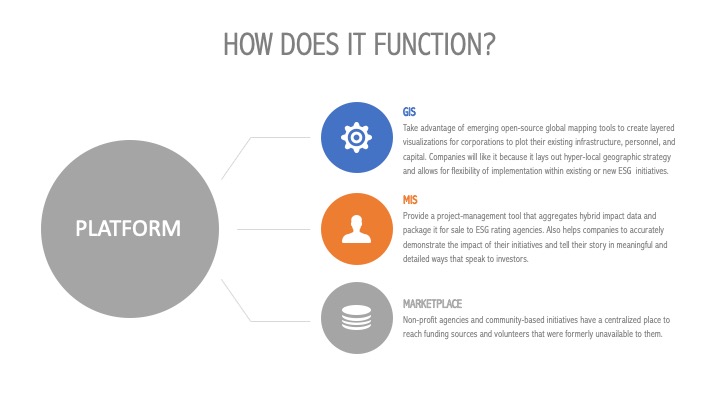
In practical terms the proposed platform would look and feel like a geospatial mapping database and project management tool that connects stakeholders across the globe through a marketplace. As someone who has worked in and with nonprofit agencies most of my career, I can attest to how difficult it is for small agencies to identify funding sources. Each donor company has a specific grant-giving protocol that must be followed and there is no guarantee of a response, let alone being selected for funding. Just identifying potential sources of funding is a huge burden for small agencies. This type of platform would streamline that process on both the agency and corporate sides of the equation.
Behind the scenes, our taxonomy and information validation pathways would facilitate a positive-feedback loop whereby the data and reflections gathered (PAR) could be packaged and sold to ESG rating agencies and financial services firms. We do not believe that we have to ”rate” our business partners directly, but that our reflections can be used to drive further investment as cultural norms and consumer demands shift.
The goal for this platform is that it remains functional and practical for an entry-level person in a variety of contexts and departments. It must also be sophisticated and nuanced enough to learn and adapt over time to our changing environment and technological capabilities.
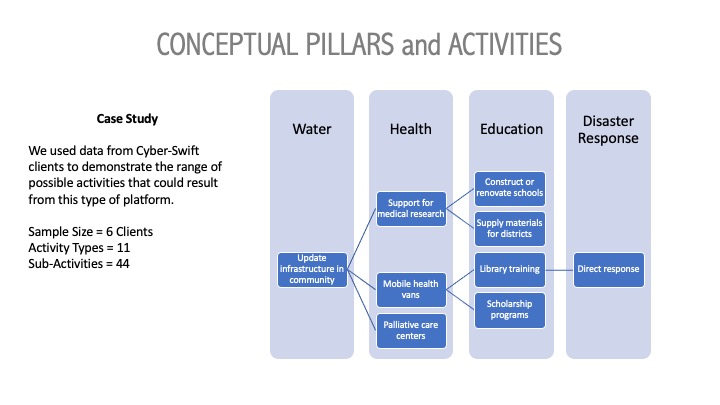
Our team member at Cyber-Swift already has a highly-customized product offering that is similar to what we propose developing as a platform.
In 2014 there was a law passed in India stating that any corporation with annual profits above a certain benchmark were required to invest 2% of those funds into CSR. We have been able to do a preliminary analysis on the activity-level data of approx. 6 corporate clients (e.g. Tata Steel, Adani Steel). The above image shows some of these activities and sub-activities to give a sense for the scope of work being done in that country by big businesses.
It is relatively simple to reverse-code those activities into buckets that correspond to global goals (e.g. UNSDGs).
We believe that for this type of platform to take root in an American market, we could ”pre-populate” various activity and sub-activity level projects for the users and create a marketplace where community-based agencies would post their projects within certain buckets associated with the broader goal. Thus making it easier to drive corporate-giving and tie those efforts back to the larger narrative around sustainability and ESG initiatives within the company.
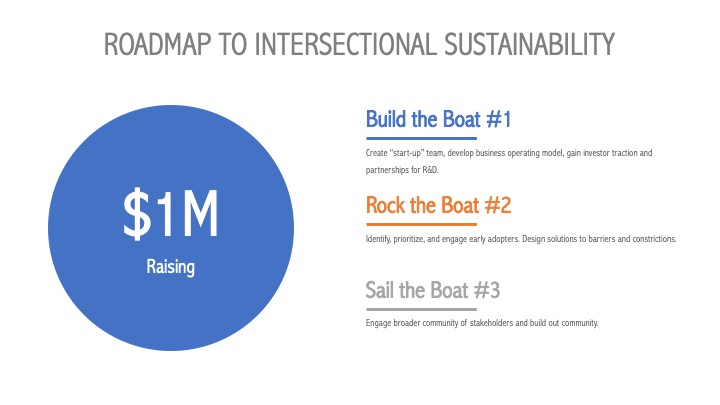
There is nothing more meaningful in life than contributing to the happiness of others. We sincerely appreciate your consideration of this novel solution to our complex global problems.
More than anything, we hope that you can imagine a future where all life is valued, where justice, equity, diversity, and inclusion are core elements of business practices across the globe. Some of you may think this proposal is naïve, and you would not be entirely inaccurate. There are many people, wise people, who believe no technological solution can fix the moral and existential crisis we all face.
To truly create change in our lifetimes at a global scale, we must first awaken from our illusion of separateness. Only then can we come together and heal.
References:
https://www.journalofaccountancy.com/news/2020/sep/global-effort-unified-sustainability-corporate-reporting.html
https://29kjwb3armds2g3gi4lq2sx1-wpengine.netdna-ssl.com/wp-content/uploads/Statement-of-Intent-to-Work-Together-Towards-Comprehensive-Corporate-Reporting.pdf
The Rise of Standardized ESG Disclosure Frameworks in the United States
https://www.pionline.com/esg/global-esg-data-driven-assets-hit-405-trillion#:~:text=The%20value%20of%20global%20assets,to%20%2440.5%20trillion%20in%202020.
https://www.scientificamerican.com/article/another-reason-top-managers-are-disproportionally-white-men/

